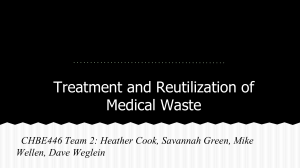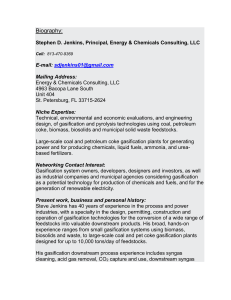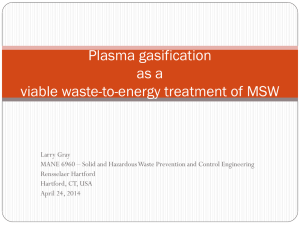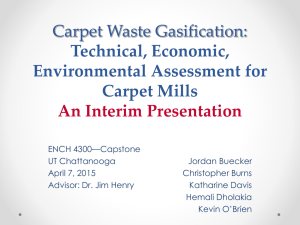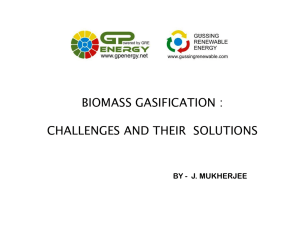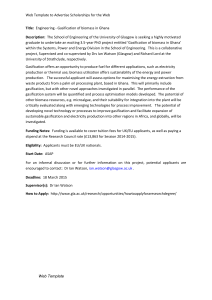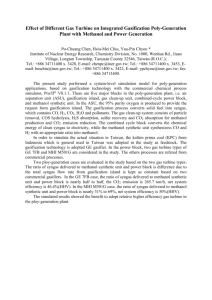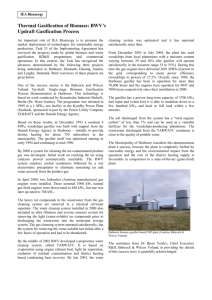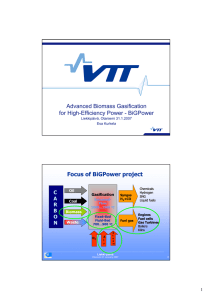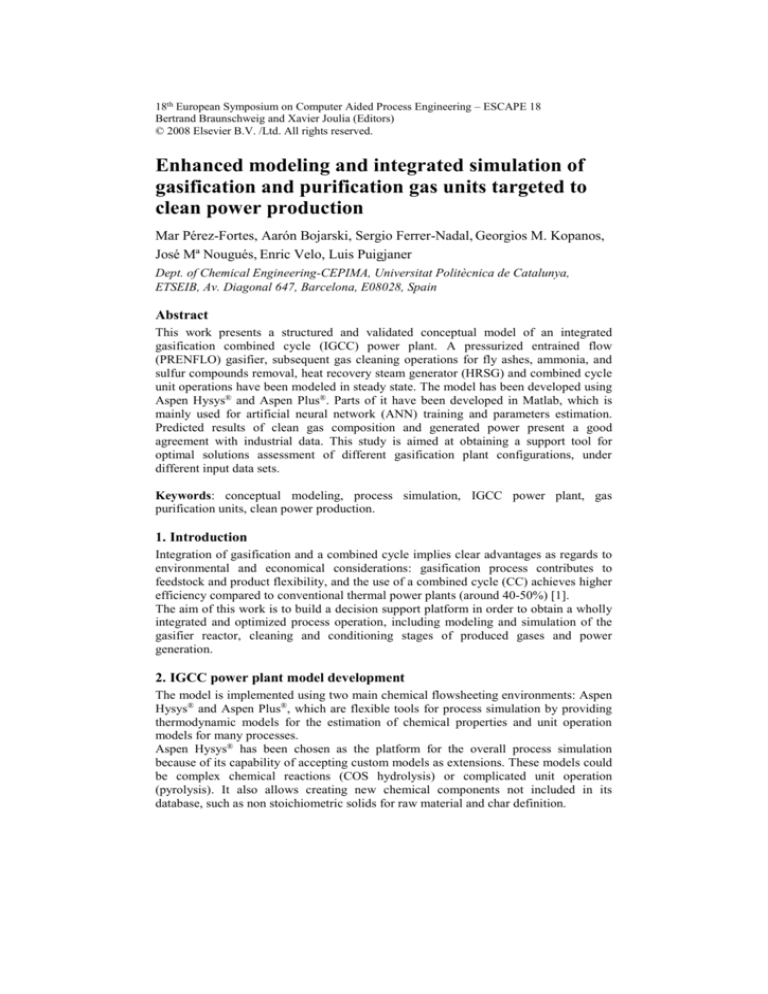
18th European Symposium on Computer Aided Process Engineering – ESCAPE 18
Bertrand Braunschweig and Xavier Joulia (Editors)
© 2008 Elsevier B.V. /Ltd. All rights reserved.
Enhanced modeling and integrated simulation of
gasification and purification gas units targeted to
clean power production
Mar Pérez-Fortes, Aarón Bojarski, Sergio Ferrer-Nadal, Georgios M. Kopanos,
José Mª Nougués, Enric Velo, Luis Puigjaner
Dept. of Chemical Engineering-CEPIMA, Universitat Politècnica de Catalunya,
ETSEIB, Av. Diagonal 647, Barcelona, E08028, Spain
Abstract
This work presents a structured and validated conceptual model of an integrated
gasification combined cycle (IGCC) power plant. A pressurized entrained flow
(PRENFLO) gasifier, subsequent gas cleaning operations for fly ashes, ammonia, and
sulfur compounds removal, heat recovery steam generator (HRSG) and combined cycle
unit operations have been modeled in steady state. The model has been developed using
Aspen Hysys® and Aspen Plus®. Parts of it have been developed in Matlab, which is
mainly used for artificial neural network (ANN) training and parameters estimation.
Predicted results of clean gas composition and generated power present a good
agreement with industrial data. This study is aimed at obtaining a support tool for
optimal solutions assessment of different gasification plant configurations, under
different input data sets.
Keywords: conceptual modeling, process simulation, IGCC power plant, gas
purification units, clean power production.
1. Introduction
Integration of gasification and a combined cycle implies clear advantages as regards to
environmental and economical considerations: gasification process contributes to
feedstock and product flexibility, and the use of a combined cycle (CC) achieves higher
efficiency compared to conventional thermal power plants (around 40-50%) [1].
The aim of this work is to build a decision support platform in order to obtain a wholly
integrated and optimized process operation, including modeling and simulation of the
gasifier reactor, cleaning and conditioning stages of produced gases and power
generation.
2. IGCC power plant model development
The model is implemented using two main chemical flowsheeting environments: Aspen
Hysys® and Aspen Plus®, which are flexible tools for process simulation by providing
thermodynamic models for the estimation of chemical properties and unit operation
models for many processes.
Aspen Hysys® has been chosen as the platform for the overall process simulation
because of its capability of accepting custom models as extensions. These models could
be complex chemical reactions (COS hydrolysis) or complicated unit operation
(pyrolysis). It also allows creating new chemical components not included in its
database, such as non stoichiometric solids for raw material and char definition.
2
M. Pérez-Fortes et al.
Alternatively, Aspen Plus® is used for calculations involving water systems and
electrolytes. These ionic models are required to solve the phase equilibrium problem for
unit operation systems such as venturi scrubbers, sour water strippers or MDEA
absorbers. The aforementioned models have been integrated in Aspen Hysys® by means
of artificial neural network (ANN) extensions. Data required to train each of the ANN’s
comes from sensitivity analysis performed with Aspen Plus® while the neural network
training is carried out using the ANN package provided with Matlab 6.5. Matlab is also
used for gasifier model parameters estimation.
2.1. Assumptions
Several assumptions throughout this work are made regarding the physical behavior of
the industrial plant and others related to the representation of such behavior in the
simulation software. In the first case, real plant operating conditions have been adapted
to the simulation environment and in the latter case they refer to assumptions adopted
within the same software.
Data from ELCOGAS IGCC power plant located in Puertollano (Madrid, Spain) are
used to define the flowsheet sequence and for testing and model validation purposes.
According to industrial data, fuel raw material is a mixture of coal and petcoke.
Ashes are a mixture of oxides primarily SiO2 and Al2O3 with traces of several other
metals. Gasifier temperature and pressure operating conditions are shown in Table 1.
Percentage of ashes that leave the gasifier reactor as slag and pollutants that pass to
chimney emissions together with fly ash, are predicted using experimental
correlations [2].
Suspended solids are separated from the synthesis gas (syngas). Thus, no solids are
assumed to be present in all downstream units, simplifying the model since only two
fluid phases, liquid and vapor, are considered.
Feedstock particles diameter is considered to be uniform and equal to 5.5 mm.
Three Rankine cycles are set, one for each available pressure at plant site.
The assumptions adopted within the software are:
All solid species considered, raw materials, ashes and char, are treated as HypoComponents in Aspen Hysys®. Raw materials and char are defined using their
ultimate analysis and heat of formation.
Thermodynamic properties for phase separation are calculated using Peng-Robinson
equation of state.
Conceptual models of every unit considered.
2.2. IGCC process description
Fig. 1 and Fig. 2 represent two snapshots of the process flowsheet in Aspen Hysys®.
An air separation unit (ASU) is used to obtain oxygen at a higher purity (85%) from air
at high pressure. Input streams to this flowsheet section (Fig. 1) are: coal and petcoke
mixture, air and demineralized water. Air is mainly used for combustion in a Brayton
cycle and to obtain the required flow of oxygen for raw material gasification. Residual
nitrogen is used in the CC to reduce NOx emissions. Output streams of this section are:
electric power generated from steam and gas turbines and flue gas which is sent out
through a chimney. Fuel raw material enters the gasifier unit where it is gasified and
converted into syngas; this outlet gas is cooled down before entering the purification
units. Heat is recovered by producing steam which is used in the CC turbines. Clean gas
coming from the purification system goes into the CC where it is burned in a Brayton
cycle. Steam is produced in a HRSG taking advantage of the high temperature arising
from gas combustion before going through the chimney.
Enhanced modeling and integrated simulation of gasification
and purification gas units targeted to clean power production
3
Fig. 1. Simulated flowsheet: pre-treatment units, gasification and power generation units.
Fig. 2 shows the flowsheet which contains all the models that mimic the plant gas
purification stages. Water and pH controlling streams (sodium hydroxide and sulfuric
acid solutions) are inlet streams for the venturi and sour water stripper units,
respectively. Other inlet streams are oxygen and air to the Claus plant. Water from the
sour water stripper, liquid sulfur produced in the Claus plant and fly ashes are outlet
streams. In the venturi scrubber, the gas is put into contact with water that absorbs and
removes pollutant species (acid and basic species). This water is cleaned downstream in
the sour water stripper. Syngas is further purified after its passage through the COS
hydrolysis reactor. This unit aims at converting all COS into H2S, which is next
removed in the MDEA absorber, maximizing sulfur retention. Polluted streams from
sour water stripper, COS hydrolysis reactor and MDEA absorber are sent to the Claus
plant, where sulfur is recovered in liquid form. A recycle gas stream from the Claus
plant goes to the COS hydrolysis reactor to further increase COS conversion. Finally,
the obtained clean gas, after the MDEA absorber, is sent into the CC.
Fig. 2. Simulated flowsheet: syngas purification units.
4
M. Pérez-Fortes et al.
3. Plant units modeling
In order to test the performance of the model, five sets of raw material compositions
have been tested. Base case considered a mixture of 50/50%wt of coal and petcoke.
3.1. Input data
Table 1 presents main input parameters and conditions from the real plant that have
been directly introduced in the plant simulation.
Table1. Operating conditions of ELCOGAS plant (“ar”: as received basis.“mb”: in mass basis).
Base Case
Mix1
Mix2
Mix3
Mix4
Input Data
Coal (%)
50
39
45
54
58
Coke (%)
50
61
55
46
42
Carbon (% ar)
61.68
68.28
64.93
61.95
60.1
Hydrogen (% ar)
2.93
3.21
3.16
3.07
3.1
Nitrogen (% ar)
3.46
1.97
2.71
3.37
3.69
Oxygen (% ar)
1.42
1.51
1.29
1.47
1.26
Sulphur (% ar)
3.34
3.79
3.43
3.24
2.97
Moisture (% ar)
2
0.75
1.04
1.29
0.93
25.17
17.3
20.49
16.8
23.44
17.1
25.61
18.2
27.95
18.5
37,847
37,197
37,638
37,997
38,456
2,600
1,600
2,600
1,600
2,600
1,600
2,600
1,600
2,600
1,600
Ashes (% ar)
Volatile Matter (%dry)
LHV (MJ/m3)
Feed (t/day)
Gasification Temperature (ºC)
Gasifier Pressure (bar)
25
25
25
25
25
O2/feedstock ratio (mb)
0.715
0.715
0.715
0.715
0.715
H2O/feedstock ratio (mb)
0.13
0.13
0.13
0.13
0.13
3.2. Gasifier
The conceptual model of the PRENFLO gasifier takes into account several assumptions.
Firstly, it considers a non-isothermal reactor by assuming adiabatic behavior, and
secondly, a feedstock that enters the reactor with a maximum of 2%wt of moisture. In a
previous step to the HRSG, a quench gas cools the syngas from aproximately 1600 to
800ºC. A conversion of around 90% of the char is obtained. The next reaction sequence
is considered to take place within the gasifier model:
Pyrolysis is modeled using a series of experimental correlations from specialized
literature [3, 4] which depend on temperature and volatile matter. Production of
pollutant species (H2S, COS, NH3 and HCN) is represented by correlations taken
from [5, 6] and industrial historic data. Every set of correlations is infered from
different coal types and analysis.
In the case of volatiles and char combustion, volatiles produced by raw material
pyrolisis are considered to be consumed by complete combustion, producing CO 2
and H2O. Kinetics of char combustion main reactions have been taken from [7, 8].
This step considers total oxygen consumption.
Char gasification comprises char-CO, char-H2O and char-H2 reactions. Their kinetic
parameters have been taken from [7, 8].
Gas equilibrium reactions are performed by minimizing the Gibbs free energy of all
present species. After this last step, syngas is obtained.
3.3. Heat recovery steam generator (HRSG)
Heat from gas turbine exhaust gases (at 535ºC) is mainly recovered by the HRSG which
produces steam at three different pressures (127, 35 and 6.5 bar). Within the high and
Enhanced modeling and integrated simulation of gasification
and purification gas units targeted to clean power production
5
intermediate pressure steam circuits, extra heat recovery is achieved by cooling syngas
(from 800 to 240ºC) and producing saturated steam.
3.4. Gas cleaning units
All purification units work at high pressure (22 bar). For the base case, this model
shows good agreement between simulated results and industrial data for the outlet
streams from venturi scrubber and sour water stripper (Fig. 3). In the case of the venturi,
the model predicts lower compositions for all species. Stripper simulation produces
values slightly higher than industrial data for CO2 and H2S, and lower for NH3 and
HCN.
Fig. 3. Comparison of ELCOGAS data and predicted values for dry gas main components of the
outlet gas from the venturi scrubber (left) and from the sour water stripper (right).
Regarding MDEA absorber behavior, (Fig. 4), a remarkable agreement exists between
industrial and model predicted composition. Comparing Claus plant results (right, figure
4), main difference between predicted and industrial composition arises in CO
composition. Amount of liquid sulfur removed is quite similar for both real and
predicted values (3113 and 2810 kg/h, respectively).
Fig. 4. Comparison of ELCOGAS data and predicted values for dry gas main components of the
clean gas (left) and the recycle gas (right).
3.5. Global model results and discussion
Table 2 shows overall simulation results compared to ELCOGAS data for different raw
material mixes. Major differences are found for N2 and water composition in clean gas
6
M. Pérez-Fortes et al.
stream. Lower volume percentages are predicted for H2 and CO, while higher values are
obtained for H2S, COS and water Simulation of produced power is in good agreement
with plant data; this comparison is worst in the case of Mix4.
Table2. Power generation and clean gas composition comparison. Error: total power deviation.
Mix1
Mix2
Mix3
Mix4
Output Data
Clean gas composition
H2 (vol. %)
CO (vol. %)
CO2 (vol. %)
Exp.
Model
Exp.
Model
Exp.
Model
Exp.
Model
21.11
62.06
1.43
19.82
49.76
2.55
21.17
61.1
2.19
19.53
49.76
2.58
21.14
60.36
2.29
19.05
49.9
2.6
19.8
60.7
3.05
18.89
49.88
2.61
N2 + Ar (vol. %)
15.34
27.54
15.47
27.81
16.14
28.11
16.36
28.28
H2S + COS (ppm)
0
0.36
0
0.38
0
0.39
0
0.38
0.07
0.32
0.07
0.33
0.07
0.33
0.08
0.33
8.259
7.985
8.126
7.956
8.038
7.923
7.796
7.905
168.7
187.5
173
183.9
163
181.4
137.8
180.6
121.5
112.5
130
109
124.8
108
109.7
105.8
290.2
299.7
3.27
303
293
-3.30
287.8
289.4
0.56
247.5
286.4
15.72
H2O (vol. %)
3
LHV (MJ/m )
Gas turbine power
(MW)
Steam turbine power
(MW)
Total power (MW)
Error (%)
Differences may be caused by a combinated effect of several simplifications that this
models relies on. Pyrolisis model estimates char, nitrogen and sulphur compounds
production., and it is based on experimental correlations. Char combustion and
gasification reactions are also based on experimental correlations. However, these
correlations have been taken from the literature and do not exactly correspond to the
actual raw material mixtures. ANN results are limited to an interval of variation of gases
composition. Also, the combustion of the clean gas is modeled with a Gibbs reactor.
4. Conclusions
A validated conceptual model of an IGCC power plant of co-gasification has been
performed with a very good agreement between model results and ELCOGAS data.
Future work will be envisaged to further improve the model simplifications and
optimize the process based on economical and environmental considerations.
Acknowledgement
Financial support received from the European Community projects (MRTN-CT-2004-512233;
RFC-CR-04006), the Generalitat de Catalunya with the European Social Fund (FI grant) and the
Ministerio de Educación y Ciencia (FPU grant) is fully appreciated. ELCOGAS IGCC power
plant provision of data for validation purposes is acknowledged with thanks.
References
[1] IGCC Puertollano ELCOGAS, 2001, A clean coal gasification power plant.
[2] CSIC (Consejo Superior de Investigaciones Científicas), Jaume Almera Institute, Spain
[3] S.Balzioc and P.G.W. Hawksley, Ind. Eng. Chem. Process Des. Dev., 9, no. 4 (1970) 521
[4] R. Loison and R. Chauvin, Chimie et Industrie, 91, no. 3 (1964) 269
[5] F. García-Labiano, J. Adánez et al., Fuel, 75, no. 5 (1996) 585
[6] S. Kambara, T. Takarada et al., Energy & Fuels, 7, (1993) 1013
[7] C.Y. Wen and T.Z. Chaung, Ind. Eng. Chem. Process Dev., 18, no. 4 (1979) 684
[8] R. Govind and J. Shah, AIChE Journal, 30, no. 1 (1984) 79


